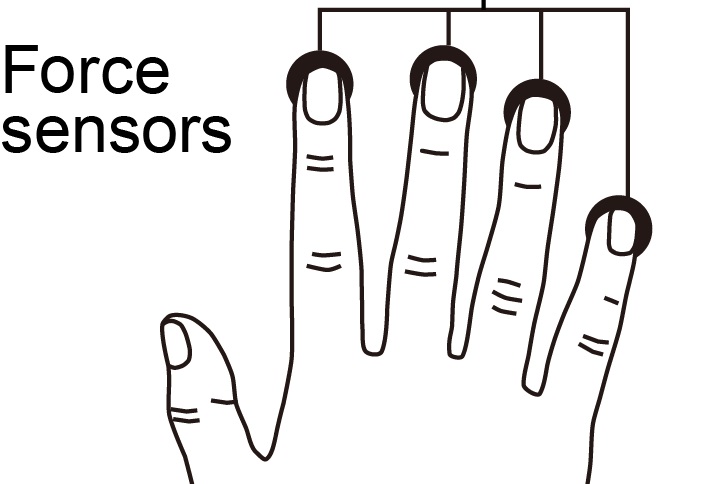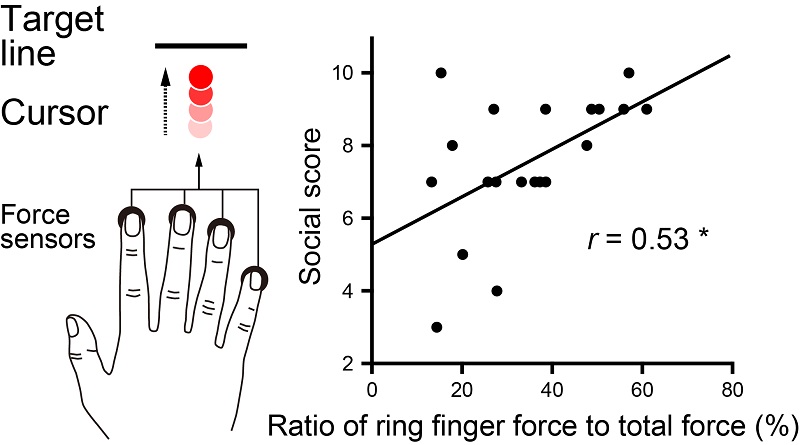Physical differences linked to social difference in autism Researchers find correlation between ring-finger dominance and social interaction scores


Participants generated forces using the four fingers besides the thumb. Their total force moved a cursor to a target line (left figure). Researchers found a significantly higher ratio of ring-finger force to total force (ring-finger dominance) in participants with autism spectrum disorder than in typically developed individuals. Ring-finger dominance was significantly correlated with the clinical score of deficits in social interaction (right figure). The higher score indicates higher severity in social interaction deficits. Each circle represents a separate participant.
© 2019 Shunta Togo and Hiroshi Imamizu.
Researchers are discovering new ways to connect the mental developmental differences of autism spectrum disorder to physical differences in motor skills.
A research group led by Professor Hiroshi Imamizu at the University of Tokyo asked 20 adults with autism spectrum disorder and 20 adults without signs of autism to place their hand on a touch-sensitive pad and exert force on the pad to move a cursor to a bar shown on a computer monitor.
The researchers found that individuals who scored higher for social impairment on social interaction tests pushed relatively harder with their ring finger than typically developed subjects, or those without autism spectrum disorder, in the small-scale study. The severity of deficits in social interaction and communications was associated with the degree of ring-finger dependence.
"I was surprised when our finding revealed a clear association between ring-finger dominance and social scores on the tests. I would be interested in future work to investigate the neural mechanisms underlying this association," said Imamizu.
This new research follows from multiple previous studies that measured the lengths of people's ring and index fingers (also referred to as the fourth and second fingers, respectively, corresponding to their order starting with the thumb). Individuals with autism spectrum disorder are more likely to have longer ring fingers relative to their index fingers than typically developed people.
Ring-finger length is affected by levels of the male hormone testosterone during prenatal development, so the finding of longer ring fingers is consistent with the extreme-male brain hypothesis of autism, which has been proposed to explain the higher incidence of autism spectrum disorder in males, says Imamizu.
These new results from the research team connect differences in finger length to functional differences in physical performance as well as social differences.
"Autism spectrum disorder has been considered a disorder of higher cognitive functions, such as social interaction and communications, rather than fundamental sensory and motor functions. However, our results suggest possible association of motor functions with cognitive functions," said Imamizu.
The research team included collaborators in Japan based at the University of Electro-Communications, Showa University Medical Institute of Developmental Disabilities Research and the Advanced Telecommunications Research Institute International.
Papers
Shunta Togo, Takashi Itahashi, Ryuichiro Hashimoto, Chang Cai, Chieko Kanai, Nobumasa Kato, Hiroshi Imamizu, "Fourth finger dependence of high-functioning autism spectrum disorder in multi-digit force coordination," Scientific Reports: February 11, 2019, doi:10.1038/s41598-018-38421-6.
Link (Publication )
)
Related links
- Graduate School of Humanities and Sociology

- Imamizu Laboratory for Learning Mechanisms, Graduate School of Humanities and Sociology

- Showa University

- Advanced Telecommunication Research Institute International

- Grant-in-Aid for Scientific Research on Innovative Areas “Understanding brain plasticity on body representations to promote their adaptive functions”






